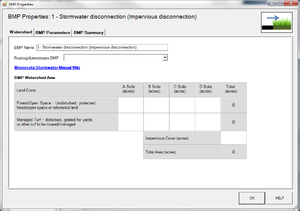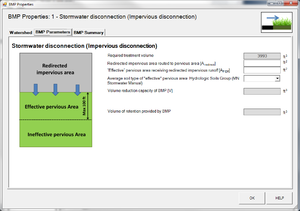
Difference between revisions of "Requirements, recommendations and information for using stormwater disconnection (impervious disconnection) BMPs in the MIDS calculator"
m |
m |
||
| Line 14: | Line 14: | ||
**'''BMP Name:''' this cell is auto-filled but can be changed by the user. | **'''BMP Name:''' this cell is auto-filled but can be changed by the user. | ||
**Routing/downstream BMP: if this BMP is part of a treatment train and water is being routed from this BMP to another BMP, the user selects the name of the BMP from the dropdown box to which water is being routed. All water must be routed to a single downstream BMP. The User must include the BMP receiving the routed water in the Schematic or the BMP will not appear in the dropdown box. | **Routing/downstream BMP: if this BMP is part of a treatment train and water is being routed from this BMP to another BMP, the user selects the name of the BMP from the dropdown box to which water is being routed. All water must be routed to a single downstream BMP. The User must include the BMP receiving the routed water in the Schematic or the BMP will not appear in the dropdown box. | ||
| − | **'''BMP Watershed Area:''' BMP watershed areas are the areas draining directly to the BMP. Values can be added for four soil types (Hydrologic Soil Groups (HSG) A, B, C, D) and for three Land Cover types (Forest/Open Space, Managed Turf and impervious). The surface area of the BMP should be included as a managed turf land cover under the hydrologic soils group of the native soils located under the BMP. Units are in acres | + | **'''BMP Watershed Area:''' BMP watershed areas are the areas draining directly to the BMP. Values can be added for four soil types (Hydrologic Soil Groups (HSG) A, B, C, D) and for three Land Cover types (Forest/Open Space, Managed Turf and impervious). The surface area of the BMP should be included as a managed turf land cover under the hydrologic soils group of the native soils located under the BMP. Units are in acres. |
*'''BMP Parameters tab''' | *'''BMP Parameters tab''' | ||
Revision as of 11:47, 30 June 2016
This page is in under review
Stormwater disconnection/Impervious surface disconnection spreads runoff generated from parking lots, driveways, rooftops, sidewalks and other impervious surfaces onto adjacent pervious areas where it can be infiltrated. All pollutants in the infiltrated water are credited as being reduced. Pollutants in the stormwater that bypasses the BMP receive 68 percent removal for total suspended solids (TSS) and 0 percent reduction for both dissolved and particulate phosphorus.
Contents
MIDS calculator user inputs for underground infiltration
For stormwater disconnection systems, the user must input the following parameters to calculate the volume and pollutant load reductions associated with the BMP.
- Watershed tab
- BMP Name: this cell is auto-filled but can be changed by the user.
- Routing/downstream BMP: if this BMP is part of a treatment train and water is being routed from this BMP to another BMP, the user selects the name of the BMP from the dropdown box to which water is being routed. All water must be routed to a single downstream BMP. The User must include the BMP receiving the routed water in the Schematic or the BMP will not appear in the dropdown box.
- BMP Watershed Area: BMP watershed areas are the areas draining directly to the BMP. Values can be added for four soil types (Hydrologic Soil Groups (HSG) A, B, C, D) and for three Land Cover types (Forest/Open Space, Managed Turf and impervious). The surface area of the BMP should be included as a managed turf land cover under the hydrologic soils group of the native soils located under the BMP. Units are in acres.
- BMP Parameters tab
- Redirected impervious area routed to pervious area (Ai indirect): The area of impervious area redirected to pervious area. The user enters the value in square ft.
- “Effective pervious area receiving redirected impervious runoff (AP eff):' The effective pervious area receiving the runoff from the redirected impervious areas. The flow length must be less than 100 ft. After 100 ft flows have a tendency to channelize reducing the effectiveness of infiltration. The user enters the value in square ft.
- Average soil type of effective pervious area – Hydrologic soil group: the hydrologic soil group (HSG) associated with the effective pervious area. The user selects the average HSG value for the effective pervious area. HSG values of A, B, C, and D can be selected.
- BMP Summary Tab: The BMP Summary tab summarizes the volume and pollutant reductions provided by the specific BMP. It details the performance goal volume reductions and annual average volume, dissolved P, particulate P, and TSS load reductions. Included in the summary are the total volume and pollutant loads received by the BMP from its direct watershed, from upstream BMPs and a combined value of the two. Also included in the summary, are the volume and pollutant load reductions provided by the BMP, in addition to the volume and pollutant loads that exit the BMP through the outflow. This outflow load and volume is what is routed to the downstream BMP if one is defined in the Watershed tab. Finally, percent reductions are provided for the percent of the performance goal achieved, percent annual runoff volume retained, total percent annual particulate phosphorus reduction, total percent annual dissolved phosphorus reduction, total percent annual TP reduction, and total percent annual TSS reduction.
Model input requirements and recommendations
The following are requirements or recommendations for inputs into the MIDS calculator. If the following are not met, an error message will inform the user to change the input to meet the requirement.
- The “redirected impervious area” cannot be greater than the impervious area routed to the BMP entered in the Watershed Tab.
- The “effective pervious area” cannot be greater than the total pervious area entered in the Watershed Tab.
Methodology
Required Treatment Volume
“Required treatment volume,” or the volume of stormwater runoff delivered to the BMP, equals the performance goal (1.1 inches or user-specified performance goal) times the impervious area draining to the BMP, plus any water routed to the BMP from an upstream BMP. This stormwater is delivered to the BMP instantaneously following the kerplunk method.
Volume Reduction
The volume reduction achieved by a BMP compares the capacity of the BMP to the required treatment volume. The “Volume reduction capacity of BMP [V]” is calculated using BMP inputs provided by the user. A stormwater disconnection BMP does not have storage capacity similar to other BMPs in the MIDS calculator. Volume reduction occurs through infiltration as the stormwater travels over the effective pervious area. To obtain an instantaneous stormwater volume credit modeling was conducted. A modeling analysis was performed to quantify the runoff reduction achieved from redirecting runoff from impervious areas to pervious areas of varying size and soil type. The long-term, 35-year continuous simulation XP-SWMM model developed in support of the MIDS performance goal development (Barr, 2011) was modified to represent watersheds with I/P ratios ranging from 0.2:1 to 50:1 and hydrologic soil types of A, B, C, and D. See the Assessment of MIDS Performance Goal Alternatives: Runoff Volumes, Runoff Rates, and Pollutant Removal Efficiencies report for additional information on the hydrologic model input parameters utilized for this model. The models results are used with a series of calculations to obtain the “Volume reduction capacity of the BMP [V]. The calculations are summarized here.
Pollutant Reduction
Pollutant load reductions are calculated on an annual basis. Therefore, the first step in calculating annual pollutant load reductions is converting the “Volume reduction capacity of BMP,” which is an instantaneous volume reduction, to an annual volume reduction percentage. This is accomplished through the use of performance curves developed from multiple modeling scenarios. The performance curves use the “Volume reduction capacity of BMP”, the infiltration rate of the effective pervious area underlying soils, the contributing watershed percent impervious area, and the size of the contributing watershed to calculate a percent annual volume reduction.
A 100 percent removal is credited for all pollutants associated with the reduced volume of stormwater since these pollutants are either attenuated within the media or pass into the underlying soil with infiltrating water. For water routed to the effective pervious area but that does not infiltrate, pollutant removal occurs through filtration. Removal rates for this water are 68 percent for total suspended solids (TSS), 0 percent for particulate phosphorus, and 0 percent for dissolved phosphorus. A schematic of the removal rates can be seen in the sidebar. NOTE: The user can modify event mean concentrations (EMCs) on the Site Information tab in the calculator. Default concentrations are 54.5 milligrams per liter for total suspended solids (TSS) and 0.3 milligrams per liter for total phosphorus (particulate plus dissolved). The calculator will notify the user if the default is changed. Changing the default EMC will result in changes to the total pounds of pollutant reduced.
Routing
A stormwater disconnection BMP can be routed to any other BMP, except for a green roof and a swale side slope or any BMP that would cause stormwater to be rerouted back to the stormwater disconnection already in the stormwater runoff treatment sequence. All BMPs cannot be routed to the stormwater disconnection BMP.
Applicability to Construction Stormwater general permit
The initial screen in the calculator requires the user to specify if they are using the calculator to determine compliance with the Minnesota Construction Stormwater general permit. If the user answers YES, the disconnection BMP cannot be used for determination of volume reductions. This is because this BMP does not capture an instantaneous volume of water, as required in section III.D.1.e of the permit. If the user chooses no, the BMP is available and the Output page in the calculator will indicate that the user has chosen not to use the calculator for determining compliance with the permit.



